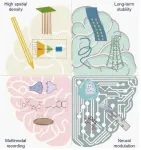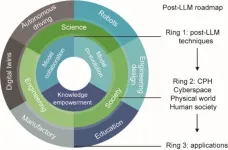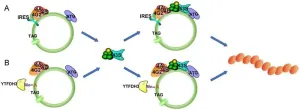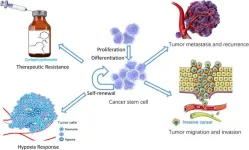(Press-News.org) Research Highlights:
Increased physical activity including taking more daily steps was linked to a lower risk of death from cardiovascular disease among postmenopausal women with a history of cancer.
The study found that engaging in one hour per day of moderate to vigorous physical activity reduced participants’ risk of death from any cause by 40% and risk of death from cardiovascular disease by 60%.
Each additional 2,500 steps per day for a participant was associated with a 34% reduction in risk of death from cardiovascular disease.
Note: The study featured in this news release is a research abstract. Abstracts presented at the American Heart Association’s scientific meetings are not peer-reviewed, and the findings are considered preliminary until published as full manuscripts in a peer-reviewed scientific journal.
Embargoed until 11 a.m. CT/12 p.m. ET, Sunday March 9, 2025
This news release contains updated information from the researcher that was not in the abstract and will be referenced in the oral presentation.
NEW ORLEANS, March 9, 2025 — Among postmenopausal women with a history of cancer, taking more daily steps and engaging in moderate-to-vigorous physical activity were both associated with a significantly reduced risk of death from cardiovascular disease, according to preliminary research presented at the American Heart Association’s Epidemiology and Prevention | Lifestyle and Cardiometabolic Health Scientific Sessions 2025. The meeting will be held in New Orleans, March 6-9, 2025, and features the latest science on population-based health and wellness and implications for lifestyle.
Physical activity is a key component of the American Heart Association’s Life’s Essential 8, a list of health behaviors and factors that support optimal cardiovascular health. The Association currently recommends that adults engage in at least 150 minutes per week of moderate-intensity physical activity (such as walking or gardening) or 75 minutes per week of vigorous-intensity physical activity (such as running or swimming), or a combination of both.
Cancer survivors are at an increased risk of death from cardiovascular disease, according to a 2019 scientific statement from the Association. The statement also noted that exercise training is an essential part of cardiac rehabilitation and recovery after cancer treatment, and that exercise therapy can help to reduce cardiovascular toxicity during cancer treatment.
“Encouraging cancer survivors to be more active, sit less and take more steps every day could be a feasible approach for prolonging survivorship and reducing the risk of cardiovascular disease mortality,” said lead study author Eric Hyde, Ph.D., M.P.H., a research analyst at the University of California, San Diego. “Our study helps us to better understand potential physical activity behaviors of postmenopausal women in relation to cancer survival.”
Researchers examined physical activity data from the Women’s Health Accelerometry Collaboration, a study combining two observational studies exploring the relationship among physical activity and sedentary behavior with cancer incidence and death. They assessed the potential associations of physical activity and sedentary behavior with death from cardiovascular disease or all-cause mortality (death from any cause).
The study followed for about eight years nearly 2,500 post-menopausal women between the ages of 63 and 99 years. The analysis included participants diagnosed with breast or other cancers at least one year before enrolling in the studies. Participants wore an accelerometer on the hip for at least 10 hours per day for up to one week. The device recorded daily physical activity, including light physical activity, moderate-to-vigorous physical activity, total physical activity and step counts. It also recorded sedentary behavior including total sitting time during awake hours.
After adjusting for age, race/ethnicity, various lifestyle and risk factors for cardiovascular disease, cancer type and years since cancer diagnosis, the study found:
More daily steps and more moderate-to-vigorous physical activity were associated with a progressively lower risk of all-cause mortality.
The greatest benefit was seen among participants who logged 5,000–6,000 steps per day, and their risk of all-cause mortality was reduced by 40%.
Each additional 2,500 steps per day was also incrementally associated with a 34% reduction in risk of death from cardiovascular disease.
The greatest benefit from moderate-to-vigorous physical activity was seen among participants with at least one hour per day, which reduced all-cause mortality risk by 40% and cardiovascular disease mortality risk by 60%. However, significant reductions in risk were also evident at amounts far below one hour per day, researchers noted.
Every 102-minutes of sitting time per day was associated with a 12% increased risk of all-cause mortality and a 30% higher risk of death from cardiovascular disease.
“Risk reductions were even evident when participants walked fewer than 5,000 steps per day, half of the often touted 10,000 steps per day threshold,” Hyde said. “Daily steps are an important measure because they are easily understood by the public, can be at any intensity level and are recorded on wearable devices like smartwatches that are increasingly being worn by all.”
Keith Diaz, Ph.D., the Florence Irving Associate Professor of Behavioral Medicine at Columbia University Medical Center in New York, a certified exercise physiologist and a member of the Association’s Physical Activity Science Committee, noted that the study’s findings add to the understanding of how to manage health and promote longevity after a cancer diagnosis.
“While structured exercise remains the most efficient and effective way to improve your health, these findings highlight that walking—at any intensity—matters. The road to an active lifestyle is more accessible than we often assume, and the benefits are available to everyone, including people navigating life after cancer,” said Diaz, who was not involved in the study.
“Another key takeaway from this study is the impact of sedentary time. Many adults now spend the majority of their day sitting, not engaged in physical activity, and for cancer survivors, this issue is likely even more pronounced due to the physical toll of cancer treatment and recovery. These findings add to the growing body of evidence that prolonged sitting is a significant health risk—one that we must actively combat, particularly after a cancer diagnosis.”
Study details, background and design:
The analysis included 2,479 women with a history of cancer, with an average age of 74 years. 52% of the study participants had a history of breast cancer; 8.5%, endometrial cancer; 7.1%, malignant melanoma; 6.6%, colon cancer; 3.0%, lung cancer; 2.1%, bladder cancer; 2.1%, rectal cancer; 2.1%, ovarian cancer; 1.7%, kidney cancer; 0.9%, head and neck cancer; 0.7%, myeloma; and 13% had a cancer that was categorized as “other.”
Data was from the Women’s Health Accelerometry Collaboration, a consortium of two studies (the Women’s Health Initiative and the Women’s Health Study) conducted between 2011 and 2015. The follow-up period to evaluate health outcomes was conducted through the end of 2022.
Daily accelerometer physical activity measures included light physical activity, moderate-to-vigorous physical activity, total physical activity and steps.
Examples of light physical activity included housework or slow walking, and moderate-to-vigorous physical activity included brisk walking, running, bike riding, playing tennis and heavy yardwork.
The study had several limitations, including lack of data regarding cancer stage at diagnosis and treatment, and physical activity was measured only once after cancer diagnosis. “In future studies, physical activity should be measured at several critical time points, such as before cancer diagnosis, during treatment and after treatment, to clarify how these changes in behavior may relate to survival,” Hyde said.
Oral Presentation 060 in Session 10A Physical Activity is Sunday, March 9, 2025 at 11:00 a.m. CT.
Co-authors, their disclosures and funding sources listed in the abstract.
Statements and conclusions of studies that are presented at the American Heart Association’s scientific meetings are solely those of the study authors and do not necessarily reflect the Association’s policy or position. The Association makes no representation or guarantee as to their accuracy or reliability. Abstracts presented at the Association’s scientific meetings are not peer-reviewed, rather, they are curated by independent review panels and are considered based on the potential to add to the diversity of scientific issues and views discussed at the meeting. The findings are considered preliminary until published as a full manuscript in a peer-reviewed scientific journal.
The Association receives funding primarily from individuals; foundations and corporations (including pharmaceutical, device manufacturers and other companies) also make donations and fund specific Association programs and events. The Association has strict policies to prevent these relationships from influencing the science content. Revenues from pharmaceutical and biotech companies, device manufacturers and health insurance providers and the Association’s overall financial information are here.
Additional Resources:
Multimedia is available on the right column of the release link.
Spanish news release (to be added)
After March 6, 2025, view the abstract for Oral Presentation 060 on the conference repository for Epidemiology, Prevention, Lifestyle & Cardiometabolic Scientific Sessions 2025 Online Program Planner.
AHA news release: For older adults, every 500 additional steps taken daily associated with lower heart risk (March 2023)
AHA news release: Taking more steps daily may lead to a longer life | American Heart Association (March 2021)
AHA health resource: American Heart Association Recommendations for Physical Activity in Adults and Kids
AHA scientific statement: Cardio-Oncology Rehabilitation to Manage Cardiovascular Outcomes in Cancer Patients and Survivors
For more news from AHA EPI Lifestyle Scientific Sessions 2025, follow us on X @HeartNews, #EPILifestyle25.
###
The American Heart Association’s EPI | Lifestyle Scientific Sessions 2025 is the world’s premier meeting dedicated to the latest advances in population-based science. The meeting is Thursday through Sunday, March 6-9, 2025, at the Hyatt Regency in New Orleans. The primary goal of the meeting is to promote the development and application of translational and population science to prevent heart disease and stroke and foster cardiovascular health. The sessions focus on risk factors, obesity, nutrition, physical activity, genetics, metabolism, biomarkers, subclinical disease, clinical disease, healthy populations, global health, and prevention-oriented clinical trials. The Councils on Epidemiology and Prevention and Lifestyle and Cardiometabolic Health (Lifestyle) jointly planned the EPI | Lifestyle Scientific Sessions 2025. Follow the conference on X at #EPILifestyle25.
About the American Heart Association
The American Heart Association is a relentless force for a world of longer, healthier lives. Dedicated to ensuring equitable health in all communities, the organization has been a leading source of health information for more than one hundred years. Supported by more than 35 million volunteers globally, we fund groundbreaking research, advocate for the public’s health, and provide critical resources to save and improve lives affected by cardiovascular disease and stroke. By driving breakthroughs and implementing proven solutions in science, policy, and care, we work tirelessly to advance health and transform lives every day. Connect with us on heart.org, Facebook, X or by calling 1-800-AHA-USA1.
END
Walking, moving more may lower risk of cardiovascular death for women with cancer history
American Heart Association Epidemiology and Prevention | Lifestyle and Cardiometabolic Health Scientific Sessions 2025 – Oral Presentation 060
2025-03-09
ELSE PRESS RELEASES FROM THIS DATE:
Intracortical neural interfaces: Advancing technologies for freely moving animals
2025-03-09
A recent study published in Engineering delves into the latest progress in intracortical neural interface technologies for freely moving animals. These interfaces, which establish a connection between the nervous system and external devices, have the potential to revolutionize neuroscience research and clinical medicine.
The researchers, led by Xinxia Cai, Zhaojie Xu and Yirong Wu, analyzed four key technological directions for ideal implantable neural interface devices: higher spatial density, improved biocompatibility, enhanced multimodal detection of electrical/neurotransmitter signals, and more effective neural modulation.
In terms of high spatial density, microelectrode ...
Post-LLM era: New horizons for AI with knowledge, collaboration, and co-evolution
2025-03-08
A recent paper published in the journal Engineering delves into the future of artificial intelligence (AI) beyond large language models (LLMs). LLMs have made remarkable progress in multimodal tasks, yet they face limitations such as outdated information, hallucinations, inefficiency, and a lack of interpretability. To address these issues, researchers explore three key directions: knowledge empowerment, model collaboration, and model co-evolution.
Knowledge empowerment aims to integrate external knowledge into LLMs. This can be achieved through various methods, including integrating knowledge ...
“Sloshing” from celestial collisions solves mystery of how galactic clusters stay hot
2025-03-08
Tokyo, Japan – The XRISM collaboration have discovered flows of hot gas in the core of the Centaurus Cluster. By comparing state-of-the-art X-ray measurements from the XRISM satellite with numerical simulations, they showed this is evidence for collisions between galaxy clusters, causing gas inside to “slosh”. This solves the longstanding mystery of how cluster cores stay hot, and sheds light on how our universe continues to evolve.
Astronomers have long envisioned how vast gravitational forces ...
Children poisoned by the synthetic opioid, fentanyl, has risen in the U.S. – eight years of national data shows
2025-03-08
Incidents of children in the U.S. being poisoned by the synthetic opioid fentanyl “increased and became more severe”, a new study reveals.
Launched today as Congress continues to review the HALT Fentanyl Act, the research follows an analysis of nonfatal fentanyl pediatric (aged 0-19) exposures reported to poison centers in 49 U.S. states from 2015 through to 2023.
In total, some 3,009 cases were detailed across the eight-year period.
In 2023 alone, 44.6% were life-threatening incidents in which there was extreme harm ...
USC researchers observe mice may have a form of first aid
2025-03-08
Humans may not be the only ones who aid their friends when they’re hurt. Mice may do it, too, as shown by a new research study led by scientists at the Keck School of Medicine of USC published recently in Science.
Scientists have been trying to understand why social mammals appear to help injured members of their species. There are numerous factors that determine empathetic behavior and social bonding in mammals, said Li Zhang, the principal investigator of the study and professor of physiology and neuroscience ...
VUMC to develop AI technology for therapeutic antibody discovery
2025-03-07
An ambitious project led by Vanderbilt University Medical Center investigators aims to use artificial intelligence technologies to generate antibody therapies against any antigen target of interest.
VUMC has been awarded up to $30 million from the Advanced Research Projects Agency for Health (ARPA-H) to build a massive antibody-antigen atlas, develop AI-based algorithms to engineer antigen-specific antibodies, and apply the AI technology to identify and develop potential therapeutic antibodies.
ARPA-H is an ...
Unlocking the hidden proteome: The role of coding circular RNA in cancer
2025-03-07
A new review article highlights the transformative role of circular RNA (circRNA) in cancer, revealing its potential as both a key player in tumor biology and a promising avenue for future therapies. Once thought to be noncoding RNA, circRNA has now been shown to encode functional proteins, challenging conventional RNA biology and opening up novel therapeutic possibilities.
Unlike traditional messenger RNA, circRNAs form a continuous loop, lacking the typical 5' cap and 3' tail. This unique structure was originally believed to preclude them from protein translation. However, recent discoveries demonstrate that specific internal ribosome entry sites (IRES) and N6-methyladenosine ...
Advancing lung cancer treatment: Understanding the differences between LUAD and LUSC
2025-03-07
Lung cancer remains one of the leading causes of cancer-related mortality, with lung adenocarcinoma (LUAD) and lung squamous cell carcinoma (LUSC) representing the most prevalent subtypes of non-small cell lung cancer (NSCLC). Despite their classification under the same umbrella, these two forms of lung cancer exhibit distinct genetic landscapes, therapeutic targets, and treatment responses.
Recent advancements in next-generation gene sequencing have identified key driver genes that differentiate LUAD and LUSC, influencing their respective clinical management approaches. LUAD is frequently associated ...
Study reveals widening heart disease disparities in the US
2025-03-07
A study published March 6 in The Lancet Regional Health — Americas highlights a growing divide in cardiovascular health in the U.S., showing that wealth and education play a significant role in heart disease risk.
The research, led by Salma Abdalla, MBBS, DrPH, an assistant professor of public health at Washington University in St. Louis, reveals that the top 20% of high-income, college-educated Americans have far lower rates of cardiovascular disease than the rest of the population — disparities ...
The role of ubiquitination in cancer stem cell regulation
2025-03-07
This review highlights the critical role of ubiquitination in governing the functionality of cancer stem cells (CSCs), shedding light on potential therapeutic targets for combating tumor progression, recurrence, and drug resistance. Published in Genes & Diseases, this article explores the intricate mechanisms through which the ubiquitin (Ub) system regulates key pathways essential for CSC maintenance and survival.
Ubiquitination, a fundamental post-translational modification, plays a pivotal role in protein stability, cellular signaling, and gene expression, particularly in the context of CSCs. Dysregulation ...
LAST 30 PRESS RELEASES:
Interaction of climate change and human activity and its impact on plant diversity in Qinghai-Tibet plateau
From addressing uncertainty to national strategy: an interpretation of Professor Lim Siong Guan’s views
Clinical trials on AI language model use in digestive healthcare
Scientists improve robotic visual–inertial trajectory localization accuracy using cross-modal interaction and selection techniques
Correlation between cancer cachexia and immune-related adverse events in HCC
Human adipose tissue: a new source for functional organoids
Metro lines double as freight highways during off-peak hours, Beijing study shows
Biomedical functions and applications of nanomaterials in tumor diagnosis and treatment: perspectives from ophthalmic oncology
3D imaging unveils how passivation improves perovskite solar cell performance
Enriching framework Al sites in 8-membered rings of Cu-SSZ-39 zeolite to enhance low-temperature ammonia selective catalytic reduction performance
AI-powered RNA drug development: a new frontier in therapeutics
Decoupling the HOR enhancement on PtRu: Dynamically matching interfacial water to reaction coordinates
Sulfur isn’t poisonous when it synergistically acts with phosphine in olefins hydroformylation
URI researchers uncover molecular mechanisms behind speciation in corals
Chitin based carbon aerogel offers a cleaner way to store thermal energy
Tracing hidden sources of nitrate pollution in rapidly changing rural urban landscapes
Viruses on plastic pollution may quietly accelerate the spread of antibiotic resistance
Three UH Rainbow Babies & Children’s faculty elected to prestigious American Pediatric Society
Tunnel resilience models unveiled to aid post-earthquake recovery
Satellite communication systems: the future of 5G/6G connectivity
Space computing power networks: a new frontier for satellite technologies
Experiments advance potential of protein that makes hydrogen sulfide as a therapeutic target for Alzheimer’s disease
Examining private equity’s role in fertility care
Current Molecular Pharmacology achieves a landmark: real-time CiteScore advances to 7.2
Skeletal muscle epigenetic clocks developed using postmortem tissue from an Asian population
Estimating unemployment rates with social media data
Climate policies can backfire by eroding “green” values, study finds
Too much screen time too soon? A*STAR study links infant screen exposure to brain changes and teen anxiety
Global psychiatry mourns Professor Dan Stein, visionary who transformed mental health science across Africa and beyond
KIST develops eco-friendly palladium recovery technology to safeguard resource security
[Press-News.org] Walking, moving more may lower risk of cardiovascular death for women with cancer historyAmerican Heart Association Epidemiology and Prevention | Lifestyle and Cardiometabolic Health Scientific Sessions 2025 – Oral Presentation 060






